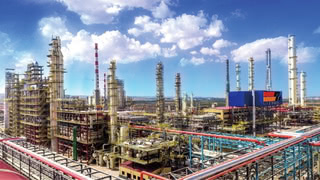How to make Green Fuels for Shipping: Bio-Methanol
Green methanol is seen as a promising future marine fuel. In the first part of a two-part series, we look at production pathways from biomass and waste.

If the shipping industry wants to reduce its climate impact, it needs to switch to fuels that are based on renewable energy. At least for larger container ships, two chemicals are considered the most promising options: Ammonia and methanol. The latter comes with the advantage that methanol engines already exist. Ferry operator Stena Line has been operating a ship (Stena Germanica) with dual-fuel engines capable of using methanol between Kiel, Germany, and Gothenburg, Sweden, since 2015.
Container shipping giant Maersk has ordered 19 ships with methanol engines. Maersk alone expects to need 6 million tons of green methanol by 2030 to meet its emission reduction targets.
Today, methanol is primarily used as a chemical feedstock, and the majority of its production is based on natural gas. In a process called steam reforming, the methane from natural gas is converted into syngas, a mixture of carbon monoxide and hydrogen. The syngas is then converted to methanol.
Around a third of the global methanol production uses coal as a feedstock, primarily in China. Syngas is produced via coal gasification, which comes with substantially higher emissions.
Methanol itself contains carbon molecules, so burning it always causes carbon dioxide emissions. In order for methanol to be green, the key question for green methanol is, therefore, where the carbon comes from. One option is to produce methanol from biomass, and there are multiple ways to do so.
Biogas, paper mills, and gasification
Fossil gas can be replaced with biomethane made from biogas. Biogas usually refers to gas produced by anaerobic digestion of biomass, and it is a mixture of mostly methane and carbon dioxide. By separating carbon dioxide, it can be upgraded to biomethane. A methanol plant using biomethane can use the same technology as a traditional fossil-based production facility. It just changes the source of the gas feedstock.
There is currently no methanol production facility that exclusively operates with biomethane. The chemical companies BASF and OCI use a mix of natural gas and biomethane in some of their production facilities. The proportionate fractions of methanol produced from biomethane are marketed as green methanol.
A Danish company, Vordingborg Biofuels, is planning a methanol plant that will operated purely on biomethane. The company plans to start production in 2024 with a capacity of up to 300,000 tons of methanol per year. This would make it one of the larger projects for green methanol production. (Also see 2025 update below.)
A different option to produce methanol from biomass is one that utilizes a waste product from paper mills. The production of pulp and paper from wood creates waste substances that already contain methanol. Today, it is usually burned and provides heat for the paper-making process.
Alberta Pacific, a paper company from Canada, has been running a small methanol purification facility with a capacity of 3,000 tons per year since 2012. Since 2021, the Swedish paper company Södra has also operated a similar methanol purification process, with a capacity of 5,000 tons per year.
The International Renewable Energy Agency (IRENA), which published a report about green methanol in 2021, estimates that if the process used by Södra would be implemented in all paper mills in Europe, it could produce around 220,000 tons of methanol per year.
Yet another path from biomass to methanol is to use gasification technology. Such technology can turn solid or liquid biomass directly into syngas by using high temperatures without combustion.
The idea of using biomass gasification for methanol production is not new. First attempts to develop such technology started back in the 1980s. However, success has been limited, and currently, there is no biomass gasification plant producing methanol.
Waste gasification has a troubled history
What does exist are plants that use gasification to process various forms of waste. But waste gasification has a troubled history. The technology has the reputation of being technically difficult, with major failures like the Thermoselect facility by energy company EnBW in Karlsruhe, Germany, and the Tees Valley project by Air Products in the UK that cost their operators hundreds of millions while largely not working.
In Japan, waste gasification projects have been more successful. However, these projects usually do not use the syngas to produce methanol.
A company that has successfully produced methanol from waste gasification is the Canadian company Enerkem. It has been operating a plant in Canada since 2014, with a capacity of 30,000 tons per year. Enerkem is currently planning to build a larger plant in Spain with a capacity of 220,000 tons per year. (Also see 2025 update below.)
LowLands Methanol, a Dutch company, plans to build a combined biomass and waste gasification plant in the port of Rotterdam, with a capacity of 120,000 tons. Gijs Bakker, CEO of LowLands Methanol, explains that the company plans to use technology that has already been successfully used in gasification plants in Japan.
"No upscaling risks will be introduced, which was the main reason for the failure of the Tees Valley project. The feedstocks will be equal to the ones used in Japan", Bakker said in a conversation with the author of this text.
A question about waste gasification is whether the methanol produced from it counts as a green fuel. Waste contains carbon content of a variety of origins. Some of it is of organic origins, like wood or paper. However, waste also contains plastics and other products made from fossil fuels.
In an indirect way, the carbon dioxide produced by burning the resulting methanol thus originates from the fossil fuel used by the chemical industry that created these plastic products. This is one reason why some companies are looking into using waste gasification as a recycling process that provides new feedstock for the chemical industry.
While biomass and waste can provide a pathway to at least greener methanol, they compete with other sectors for limited feedstock resources, and production will probably not be able to meet future demand. It is, therefore, expected that e-methanol — made with electricity from hydrogen and carbon dioxide — will have to play a role, too. We will cover that in part two.
Update (Apr 03 2025)
The original article claimed that Enerkem was building a larger plant in Spain. That was incorrect in 2022, and is still incorrect, but that plant received an investment decision in early 2025. Enerkem's plant in Canada was shut down in 2024. (See also here for an update on Enerkem.)
Likewise, the original article implied that Vordingborg Biofuesl was already building a plant, which was incorrect. Vordingborg Biofuels also has not started producing methanol in 2024, as originally announced. The company has since been renamed to Green2x and focuses on biomethane instead of methanol. According to its web page, Green2x plans the construction of a pilot plant in 2025.
LowLands Methanol still plans a gasification facility in Moerdijk near Rotterdam with a production capacity of 120,000 tons anually. According to a recent article by Argus, production was initially planned for 2024, but has been delayed to 2027 or 2028. LowLands CEO Gijs Bakker told Argus that the company has signed several supply agreements with shipping firms.
This text was originally published in 2022 on the shipping news web page Fathom World, which is no longer online. I am republishing my old articles here with minor corrections and updates.
Author: Hanno Böck



